AX1379
Using the Row editor, define fixed row structures for use in web reports. Fixed row structures define the following:
- The sections to appear in the report, including section titles and subtotal rows
- The data rows to appear within each section
When you use the Intelligence Center to create a new fixed row structure or to edit an existing fixed row structure, it opens in the fixed row structure editor.
Overview
By default, the Row editor consists of two primary areas:
- The section editor on the left side, where you can add, reorder, and remove sections and data rows.
- The property editor on the right side, where you can define properties for the overall row structure, the selected section, or the selected row.


If the row structure is configured to Use Dimension Mapping to define the row data, then another area is available using the Dimension Mapping tab. You can use the Dimension Mapping area to map dimension items to individual data rows. For more information about using dimension mapping, see Use the Dimension Mapping editor.
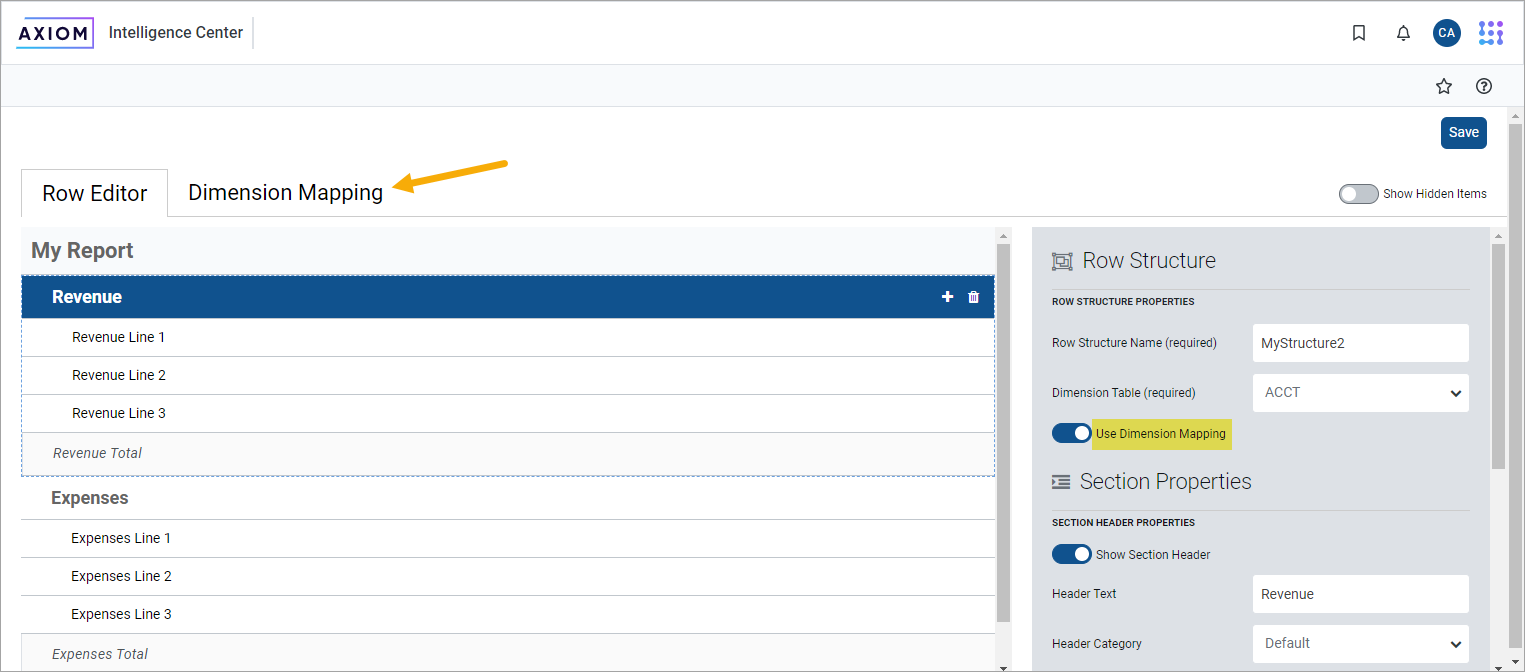
To save the row structure after making changes, click Save located at the top right of the editor.
You can configure certain parts of the row structure as hidden, such as section header rows or total rows. By default, these hidden items no longer appear in the editor. If you need to view these items so that you can work with them and configure them, toggle the option Show Hidden items at the top right of the editor.
Use dimension mapping versus row filters in a fixed row structure
When you build a fixed row structure, there are two different ways to define the data to be shown each in row:
-
Filters: Each row can have a filter criteria statement that defines the data for that row. For example,
Acct.Acct=4100orAcct.Category='Revenue'. -
Dimension mapping: You can assign each row one or more items in a specified dimension. For example, if Acct is the specified row dimension, you can view the list of accounts and map them to specific rows in the report, as needed.
The filter option is the most flexible way to build a fixed row structure, because:
- You can use any valid filter criteria statement to define the data in each row, including compound statements using AND or OR, and referencing any table (not just the specified dimension table).
- You can define filters at the section level, which combine with all row-level filters in the section.
- You can repeat dimension elements within the row structure (for example, to create multiple sections that show revenue for different regions or lines of business).
However, because the filter option is more flexible, it also requires a more advanced level of knowledge about your data structures. Do not create invalid or conflicting filters and ensure that your filters result in the data that you want to appear in the report.
In contrast, the dimension mapping option is the easiest to set up because:
- You are presented with a full list of all items in the specified dimension, which you can search and filter, as needed.
- To assign an item to a row in the report, select the item and then click the arrow button to move it over to the row. Each row can be assigned as many items in the dimension, as needed.
- You can see exactly which dimension items appear on each row and see which items have not yet been assigned to rows.
However, the dimension mapping option is less flexible. Rows can only show data from the specified row dimension and you can only assign each item in the dimension to a single row.
Row structure properties
The following required properties at the top of the right pane apply to the entire row structure.

| Item | Description |
|---|---|
|
Row Structure Name |
The name of the row structure. The name identifies the row structure so that it can be selected when creating or editing a web report. |
|
Dimension Table |
The primary dimension table to be used on the data rows. You can select any reference table in your system. Use this selection as follows:
|
|
Use Dimension Mapping |
Specifies whether you define the data in data rows by using filters or by using dimension mapping. By default, this is disabled, so data is defined using filters. If instead you want to use dimension mapping for the rows, click the toggle switch to enable this option. The toggle switch is green when enabled and gray when disabled. If you enable Use Dimension Mapping, the row structure editor updates as follows:
For more information about the differences between using filters or dimension mapping to define data rows, see Use dimension mapping versus row filters in a fixed row structure. |
Add, remove, and reorder sections
Using the Row Editor tab, build your row structure by adding, removing, or reordering sections. Each row structure starts with a top-level root section that includes an optional header and an optional grand total.

To add new sections to the row structure, select the section header row—the Root Section row—and then click the plus sign + and select Add New Section.

The new section is added within the root section. You can continue to add as many sections, as needed, at this level.
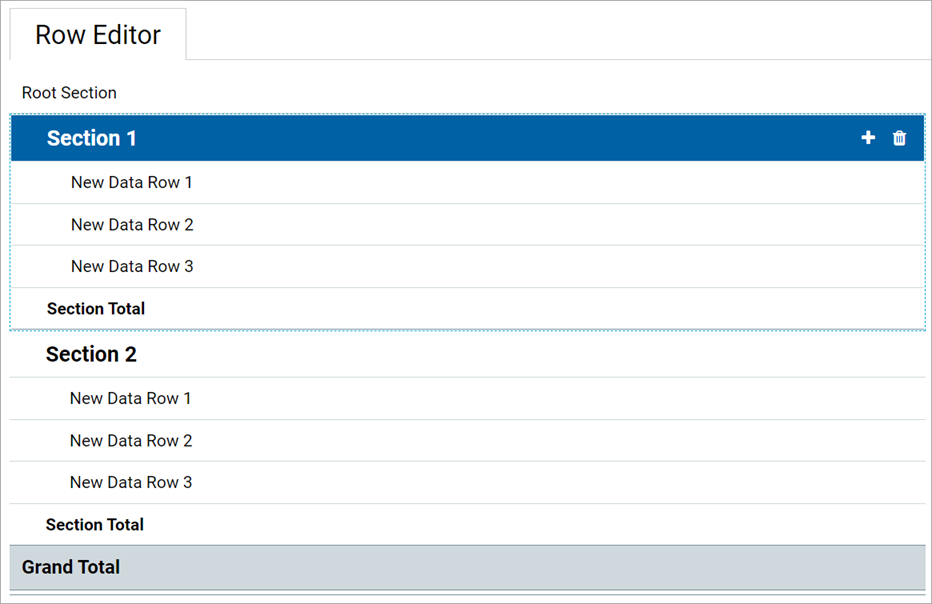
To add subsections within a section, select the section header row for any section, and then click the plus sign + and select Add New Section. The new subsection is added to the current section. Nest as many section levels, as needed, by adding subsections to sections.
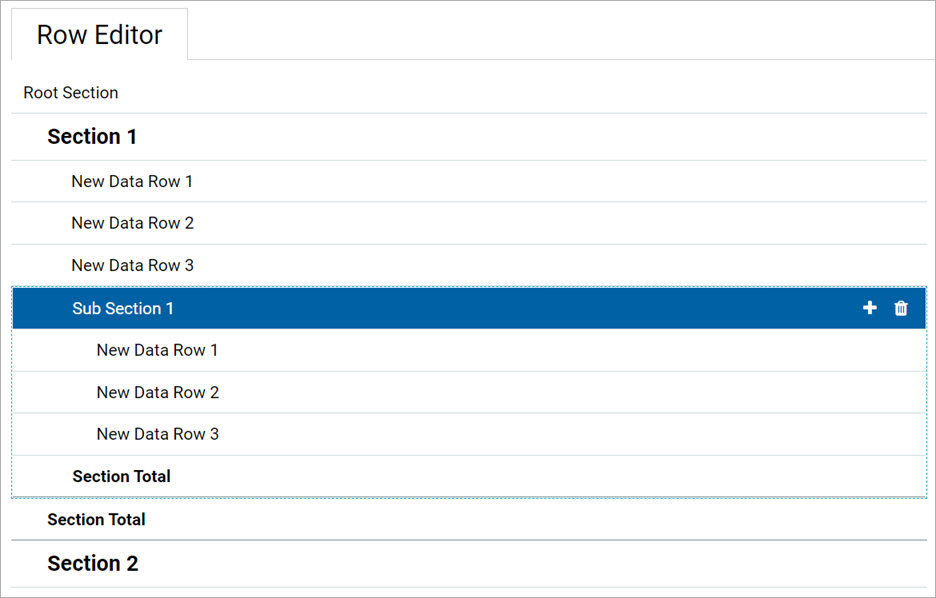
Newly added sections use default text and styling, which can be configured for each section. Each newly added section consists of the following by default:
-
A header row to show optional header text for the section. If you do not want a header row to appear for a particular section (including the root section), you can hide it by disabling Show Section Header when configuring the section properties.
-
Three data rows to show queried data in the section. You can add or remove data rows, as needed.
-
A total row to show the totaled data for the section. If you do not want a total row for this section (including the root section), hide it by disabling Show Section Total Row when configuring the section properties.
After you have added sections, you can make further section changes as follows:
-
To reorder sections: Select the header row of a section and then drag it to a new location within the same level of the structure. For example, if you have three sections at the same level, you can drag these three sections to change their order. You cannot drag one of these three sections to a lower level or a higher level.
-
To delete a section: Select the header row of the section and then click the delete icon
 . The section and all of its subsections are deleted. You cannot delete the root section as it is required.
. The section and all of its subsections are deleted. You cannot delete the root section as it is required.IMPORTANT: Ensure you no longer need the section before clicking the delete icon. The section is deleted immediately with no confirmation prompt. If you deleted a section by accident, you can exit the row structure editor without saving but you also lose any other unsaved changes that you have made during the current session.
Section properties
To configure the properties for a section, select the section header and then complete the Section Properties in the right pane.
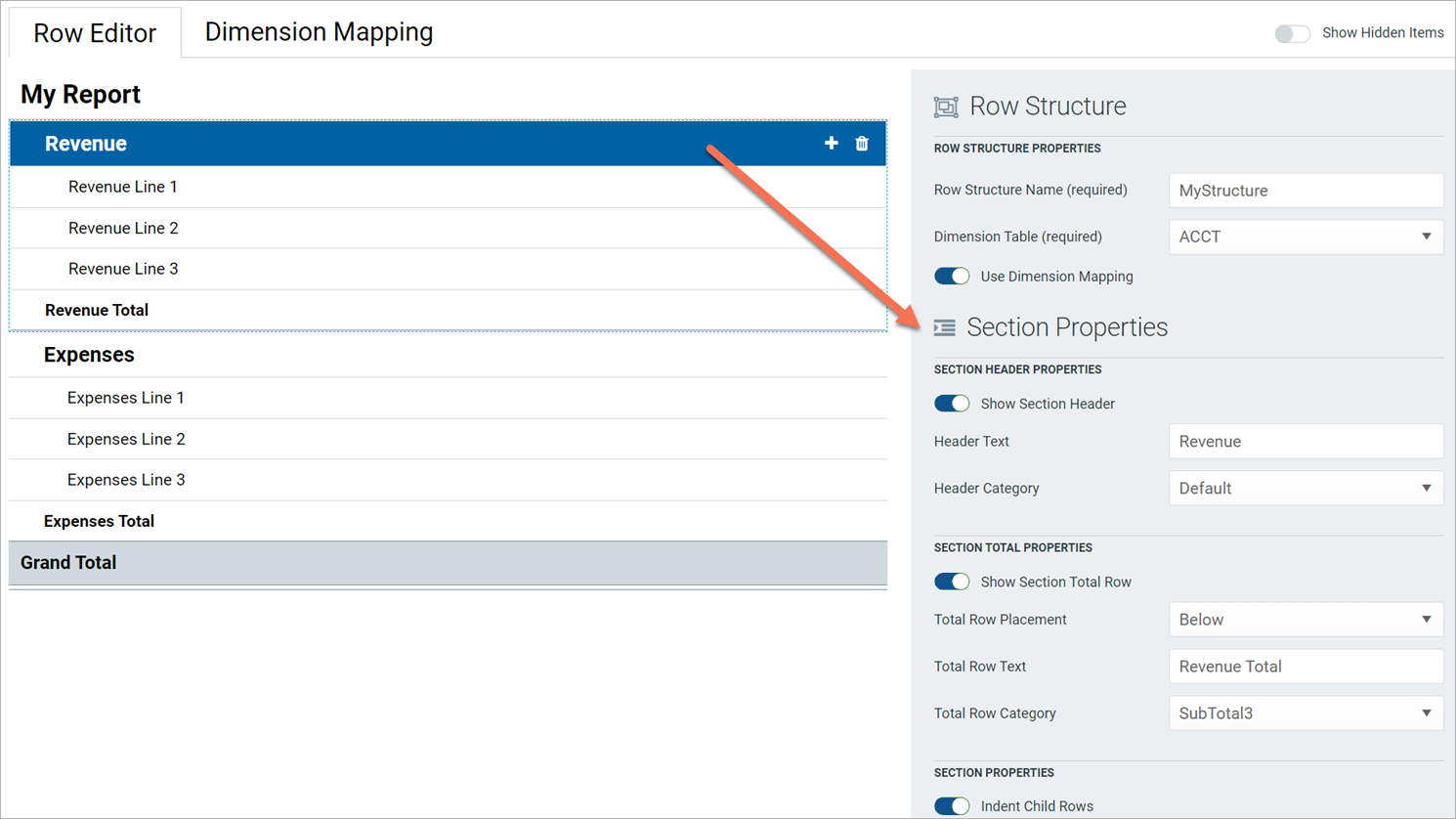
Section Header properties
| Item | Description |
|---|---|
|
Show Section Header |
Specifies whether the section header row is visible when the row structure is used in a report. By default, this option is enabled, so the section header row is visible. If you do not want this section to have a header row, disable this option. The toggle switch is green when enabled and gray when disabled. If you disable this option, the remaining section header properties are hidden because they do not apply. You may want to define header text before disabling the option to make it easier to identify the section when working within the row structure editor. NOTE: If you hide the section header, you cannot select the header row in the editor to add rows or subsections, configure the section, reorder the section, or remove the section. To work with the section header row, enable the option Show Hidden Items located at the top right of the editor. This causes all hidden items to show in the row structure so that they can be selected and configured. |
|
Header Text |
The text to display on the section header row. By default, this is set to "Root Section" for the root section header and "Section" for all other newly added sections. Edit the header text to reflect the data shown in this section. |
|
Header Category |
The style to use on the section header row. The style determines display attributes, such as font size and font weight. Select one of the following:
By default, the header category is set to Header1 for the root section header, and Default for all newly added sections. |
Section Total properties
| Item | Description |
|---|---|
|
Show Section Total Row |
Specifies whether the section total row is visible when the row structure is used in a report. By default, this option is enabled so the section total row is visible. If you do not want this section to have a total row, disable this option. The toggle switch is green when enabled and gray when disabled. If you disable this option, the remaining section total properties are hidden because they do not apply. |
|
Total Row Placement |
The location of the total row in the section either Below the data rows or Above the data rows. The total row is located below the data rows, by default. |
|
Total Row Text |
The text to appear on the section total row. By default, this is set to "Grand Total" for the root section total and "Section Total" for all other newly added sections. |
|
Total Row Category |
The style to use on the section total row. The style determines display attributes, such as font size, font weight, shading, and borders. Select one of the following:
By default, the total row category is set to Grand Total for the root section total row, and Subtotal3 for all newly added sections. |
Section properties
| Item | Description |
|---|---|
|
Indent Child Rows |
Specifies whether the rows in this section are aligned with the section header row or indented. By default, this is enabled, so the rows are indented. If instead you want the rows to be aligned with the section header row, disable this option. The toggle switch is green when enabled and gray when disabled. |
|
Parent Total Row Behavior |
Specifies how the data in this section is treated when computing the total row of the parent section. Select one of the following:
Although this option appears on the root section, it does not apply because the root section does not have a parent section. For example, imagine that you have a parent section with two subsections. Subsection A totals 5000 and Subsection B totals 1000.
|
|
Section Data Filter |
Optional. A data filter to apply to all of the data rows in this section, including any subsections. Use this when all rows in the section need to be filtered by a particular dimension or grouping so that you do not need to repeat that dimension grouping on each individual data row. Only applies when you disable Use Dimension Mapping. Enter the filter criteria statement to apply to the data rows in this section. Section data filters use normal filter syntax for Axiom Budget Planning and Performance Reporting. Although you can use the Filter Wizard to create the filter criteria statement, it is limited to creating filters based on the specified dimension table for the row structure. In many cases, the section data filter needs to use a different dimension so you must manually create the filter criteria statement. For example, imagine that you want to show revenue accounts in the rows of your report but you want to split the data into two sections reflecting two different sales regions. You can create two sections and define section filters for each, such as |
Add, remove, and reorder data rows
Using the Row Editor area, you can add data rows to a section, remove unneeded rows, and reorder rows. Each data row represents a record of data that you want to query from the database and display within the report.
-
Select the section header row, and then click the plus sign + and select Add Data Row.
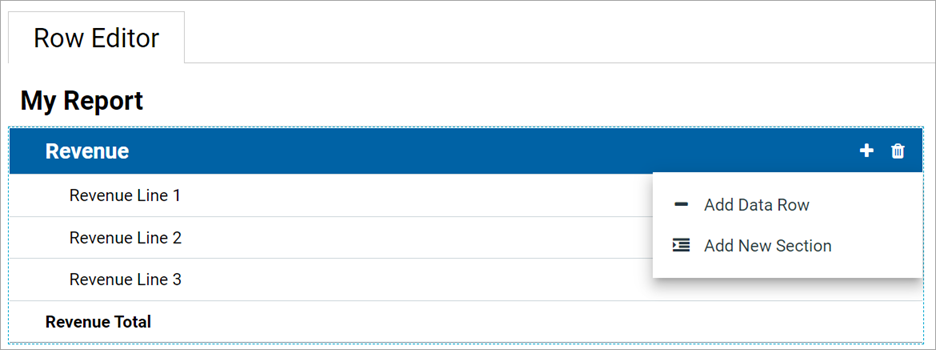
The new row is added to the bottom of the section. Continue to add as many new rows to the section, as needed.
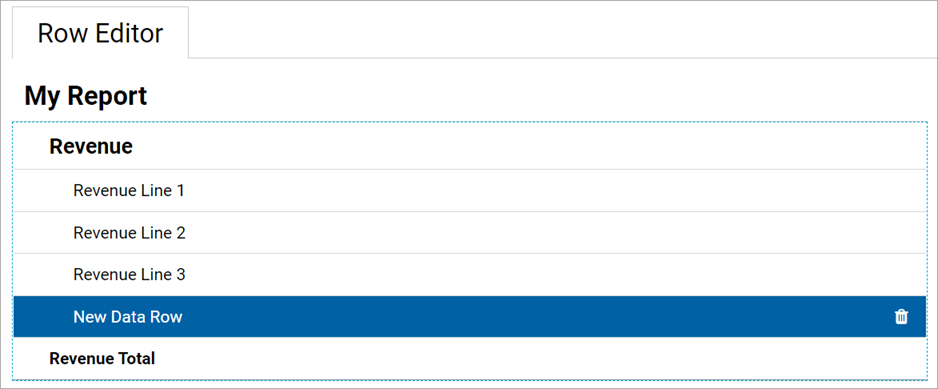
After you have added data rows, make further row changes as follows:
-
To reorder rows: Select the data row to move, and then drag it to a new location within the same section. For example, if you want a newly added row to be at the top of the section instead of the bottom, drag it to that location. You cannot drag the row to a different section, not even to subsections of the current section.
-
To delete a row: Select the data row to delete and then click the delete icon (trash can)
 . The row is deleted.
. The row is deleted.IMPORTANT: Ensure you no longer need the row before clicking the delete icon. The row is deleted immediately with no confirmation prompt. If you deleted a row by accident, exit the row structure editor without saving but you will also lose any other unsaved changes that you have made during the current session.
Only data rows can be individually added, deleted, and reordered. Section header rows and section total rows are not considered to be data rows and are managed as part of the section. Note the following:
- The delete icon on section header rows does not delete the header row; it deletes the entire section. If you do not want a particular section to have a header row, configure the section to hide the header row.
- Section total rows do not have delete icons. If you do not want a particular section to have a total row, configure the section to hide the total row.
- Section header rows are always located at the top of the section. When you drag a section header row, you are moving the entire section, not just the header row. It is not possible to move just the header row.
- Section total rows can be located at either the top or bottom of the section, but not by dragging. When you configure the section, specify the location of the total row.
Row properties
To configure the properties for a data row, select the row and then complete the Row Properties in the right pane.

| Item | Description |
|---|---|
|
Row Text |
The text to appear on the data row. By default, this is set to "New Data Row." Edit the row text to reflect the data shown on this row. For example, if this row is going to show data for the Travel account, the row text should be something like "Travel" or "Account 5000 - Travel". |
|
Data Filter |
A filter criteria statement to define the data to query into this row. Only applies when you disable Use Dimension Mapping. If you enable dimension mapping, use the Dimension Mapping tab to map the data for this row. Row filters use normal filter syntax for Axiom Budget Planning and Performance Reporting. You can enter the filter or use the Filter Wizard to create a filter based on the specified Dimension Table for the row structure. For example, if the data filter is Each row's data filter is independent from any other row and does not need to use the same grouping level or even the same dimension as other rows. For example, one row can be
|
If the row uses a data filter, the row's data filter iscombined with any upstream section data filters (using AND). For example, imagine the row structure has sections and rows configured as follows:
| Parent Section Filter | Dept.Company='Company A'
|
| Current Section Filter | Dept.Region='US West'
|
| Row Filter | Acct.Acct=4000
|
Then the data for this row is determined as follows:
Dept.Company='Company A' AND Dept.Region='US West' AND Acct.Acct=4000
